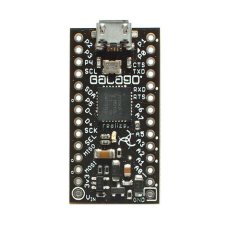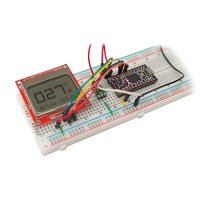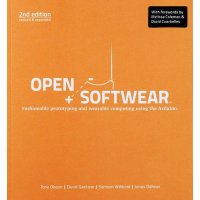Galago in one line: Revolutionary Arduino alternative with an ARM chip, incredible features, great open source tools, tiny footprint and built-in debugger.
Tiny Revolution.
Galago fits a powerful 32-bit ARM chip, an on-board debugger and other incredible features in a tiny format to instantly improve your electronic projects. It's open hardware and you develop software for it with open, cross-platform and easy-to-use tools. Everything about Galago is optimized to help you make things better.
What is Galago?
Galago is a tiny revolution in rapid electronics prototyping. It combines a powerful ARM Cortex-M3 microcontroller with a hardware debugger on a tiny circuit board, allowing hobbyists and professionals alike to turn project ideas into reality faster and better than other microcontroller platforms. Galago's debugger is the difference between starting a project ... and finishing it.
How can you use it?
Plug Galago into a standard breadboard for quick prototyping, pop it into an app board to build an application or integrate it directly into your commercial product. Galago is inexpensive enough that you can leave it built into a project and is the first prototyping platform specifically designed to be cost-competitive with custom PCB engineering for small production runs, at under $10 in 1000-unit quantities. This means you can prototype a product with Galago, put it on Kickstarter and afford to produce the first batch using the same hardware you prototyped with. Incredible!
How Galago compares
Perhaps the best feature of Arduino, and the reason people choose it over other prototyping boards, is the consistent, easy-to-use development software. There are faster, smaller, better and less expensive prototyping boards everywhere, but none have the complete start-to-finish usability of Arduino. That is, until Galago came along. Because Galago is built on the principle of putting development experience first (instead of just selling products) you can expect a friendlier, more usable board than any other, including Arduino. Moreover, Outbreak is committed to your experience and we'll continue to improve the development tools, libraries and community integration features as we develop new app boards.
The Teensy 3.0 is the same size and shape, but there's an important difference between the two development boards, however: The Teensy 3.0's chip has more memory, but the Galago has a 50% faster processor, a smart, flexible power supply and the all-important debugging feature. This means that if you wrote a project on the Teensy and it didn't work, you'd have to guess why it's not working and spend a fair amount of time identifying the problem. Galago's debugger shows you what's happening inside the chip as it runs, so you can stop the program, look at the value of variables and figure out very quickly what part of your project isn't working and why. The debugger gives you an unparalleled level of insight for such a small board and helps you build more ambitious projects with less wasted time so you can make things better!
Developing with Galago
Galago plugs into a standard solderless breadboard or an app board and connects to your computer with USB. The USB connection permits downloading and debugging firmware, plus it will power Galago if it's not connected to another power source.
Write C, C++ or Wiring code with Galago's simple but powerful development enviroment and deploy it to the hardware with a single click. Galago's community features make sharing code and working on it with others extremely simple.
Use the integrated debugger to pause code execution, inspect variables and continue running - this helps you quickly find software problems as they arise to fix them faster with less head-scratching.
What makes Galago different
Both in the sense that the debugger offers you vision into how your software is running on the device and in the overall vision of the project. Galago is the only platform expressly designed to be both extremely easy to prototype on and economically viable to build straight into medium-run commercial products. By allowing you to accelerate to shipping real products faster, you can try more adventurous ideas with lower risk than ever before. Galago also enables smaller teams, less-experienced designers and lower budgets. All of these advantages help you make things better.
Technical specifications
72 MHz 32-bit ARM CPU with 32KB of flash ROM and 8KB of RAM
Integrated hardware debugger
One high-speed SPI port, up to 36 Mbps
One high-speed I2C port, up to 1.5 Mbps
One UART/USART with hardware flow-control capability, up to 256 kbps
10 high-speed PWM pins, 6 driven by 32-bit (high-resolution) timers
6 ADC (analog) input pins with 10-bit resolution at over 400 KSa/sec
25 GPIO (digital) input/output pins
Galago has 11 PWM channels, most of which offer 32-bit precision. This is over 65,000 times more precise than Arduino's 16-bit PWM. The six analog channels can sample over 400,000 times per second. Digital I/O can toggle tens of millions of times per second. So yes, it's fast.
Libraries and Software
Because Galago uses a popular ARM chip, lots of existing code and libraries can be brought to the platform with ease. Galago's debugger provides an advantage here too because new code is always easier to get working when you have this level of insight.
Galago
- Brand: Outbreak Inc.
- Product Code: KS-Galago-Board
- Reward Points: 26
- Availability: In Stock
- रo 2,600.00
-
रo 885.00
- Price in reward points: 2600
Related Products
Galago Advanced Kit
A kit including the super fast Galago Board and some essential components to get started right-away ..
रo 1,985.00 रo 5,450.00
Open Softwear 2nd Edition
Open Softwear is a book about fashion and technology. More precisely it is a book about Arduino boar..
रo 425.00 रo 1,250.00
Tags: Galago, Development, Board







